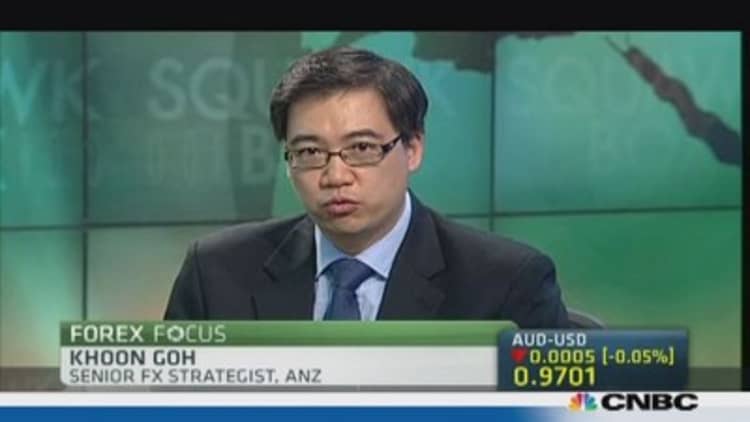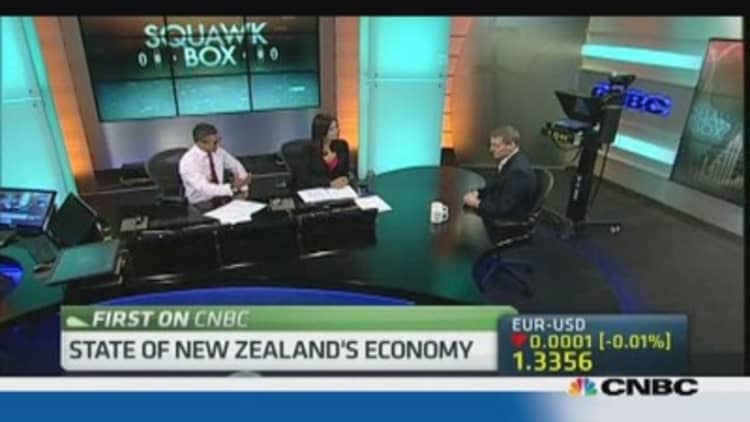The enjoyed a strong 2013, and its fortunes are expected to be even brighter this year, analysts say.
The Kiwi – as it is broadly referred to by FX traders – has notched up around 6 percent of gains against the greenback since late June, as rhetoric from its central bank turned increasingly hawkish.
(Read more: Rate hike talk boosts New Zealand dollar)
In 2013, the currency fared particularly well against the Japanese yen, gaining 20 percent, while the Aussie-Kiwi cross touched its weakest level in five years last month, as the Aussie dropped 14 percent against the greenback in 2013.
According to Kathy Lien, managing director of BK Asset Management, New Zealand stands out from other major western economies.
"The Reserve Bank of New Zealand will be the only major central bank raising interest rates [in 2014] and this unique position makes the New Zealand dollar one of our favorite trades for 2014," she said.
(Read more: Markets focus on rupee, rupiah... and the kiwi?)
According to Lien, there will be three major drivers for investors in the Kiwi in 2014: expectations for strong economic growth, the expected rate hike, and increased demand for soft over hard commodities – New Zealand's major export.

New Zealand's economy grew robustly in 2013, despite a number of headwinds including a slowdown in its major trading partners, natural disasters and currency strength. The economy posted its fastest pace of growth since 2009 for the third quarter, and is expected to grow at an annualized pace of 2.7 percent for the fiscal year ending in March 2014.
Lien said the economy was boosted by the recovery efforts following a major drought and the 2011 Christchurch earthquake, a trend she expects to continue.
(Watch now: Air New Zealand shares sink after stake sale)
"It is important to remember that New Zealand is a very small economy and major infrastructure projects can have a significant impact on growth," she said.
However, alongside healthy growth comes inflation expectations, and New Zealand's property market is showing signs of overheating.
Along with many other market analysts, Lien expects the Reserve Bank of New Zealand to hike interest rates in March, from current levels of 2.5 percent, a move that will be positive for the Kiwi. New Zealand already has the highest interest rates among the G10; a rate hike would make it the first western economy to hike rates for some time.
(Read more: We can't influence 'currency war': New Zealand)
"The first rate hike from the RBNZ is expected in March and the prospect of tightening should fuel additional gains in the New Zealand dollar," Lien said, adding that the RBNZ is expected to continue on a rate hike path, raising rates to 4.75 percent (or by 225 basis points) in a little over two years' time.

Finally, Lien said one of New Zealand's key exports - milk powder - would put it at a distinct advantage against neighboring Australia, which it competes with for Chinese demand. Lien pointed out that China is likely to up its intake of milk powder in the coming years, especially as the country relaxes its one child policy.
"Approximately 90 percent of New Zealand's milk powder is sold to China, and as the middle class in China and India grows, their demand for milk and protein will increase," she said, adding that recent contamination scares – as was seen with Fonterra earlier in the year – did pose a risk to this trend, in the event of reputational damage.
Other analysts highlighted risks to the Kiwi trade, such as the chances that a hawkish move by the RBNZ is already priced in.
(Watch now: What impact could the Fed have on New Zealand?)
"The idea of policy divergence among central banks is not new," said trading firm IG's chief market strategist Chris Weston.
"The key issue is that the market is already pricing in aggressive rate hikes over the next twelve months...[But] history has shown us that when the RBNZ move they tend to move fairly aggressively and from a psychological perceptive the threat of being the most hawkish central bank in G10, mixed with the highest real yields makes the currency very attractive," he said.
The Kiwi traded at 0.8214 to the U.S. dollar in lunchtime Asia trade on Thursday.
—By CNBC's Katie Holliday: Follow her on Twitter @hollidaykatie


